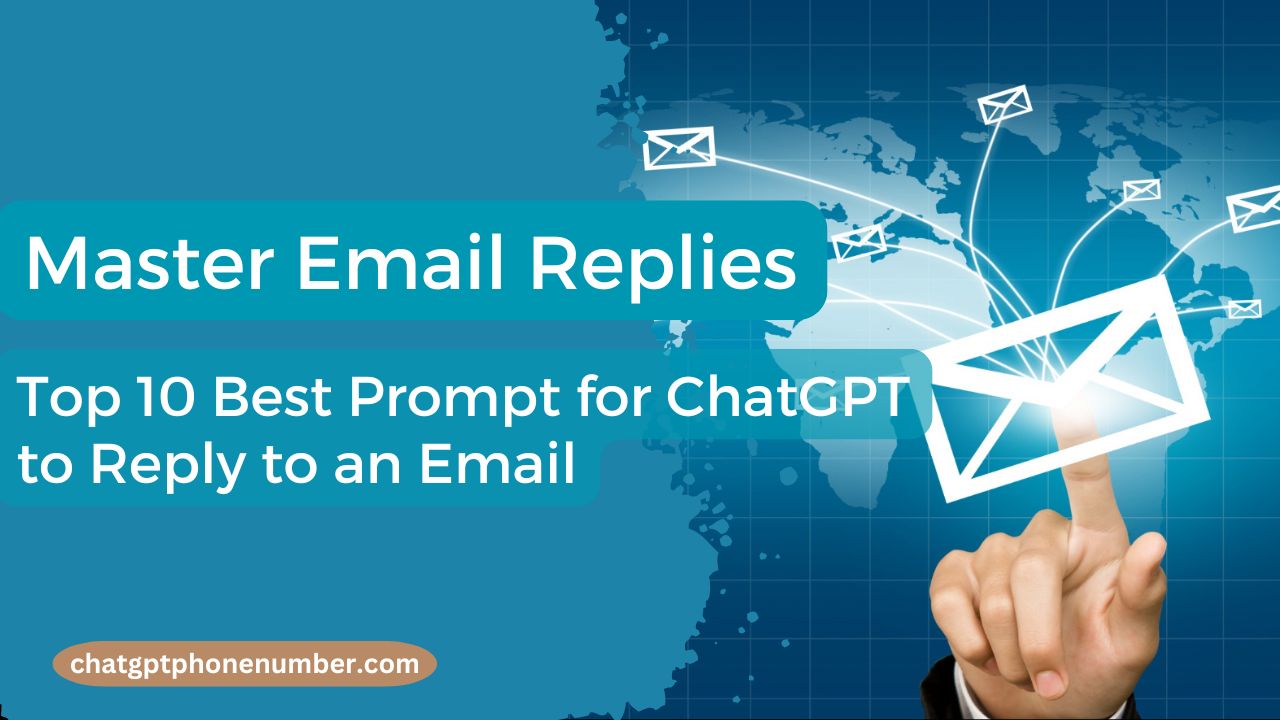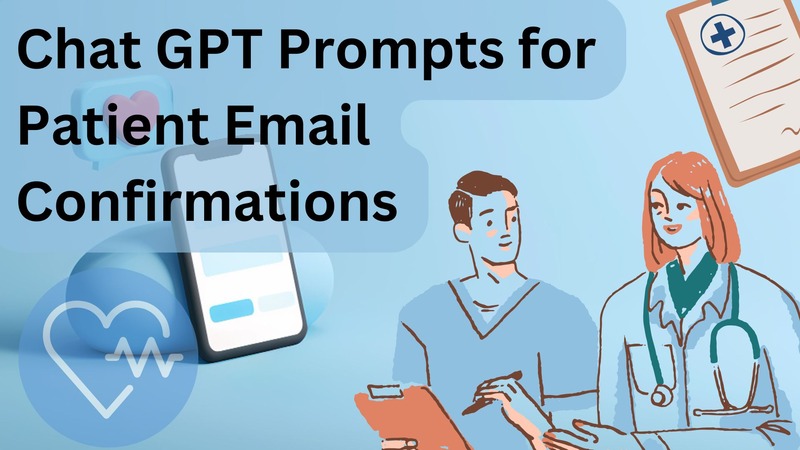Have you ever found yourself staring at your inbox, unsure how to reply to a tricky email? We’ve all been there, right? Whether it’s a professional email, a tricky customer service issue, or a personal message, crafting the perfect response can be a daunting task. Here’s where the prompt for ChatGPT to reply to an email comes in. With the right prompt, you can get ChatGPT to draft a reply that is clear, professional, and tailored to your needs in seconds. This technology can truly change the way we communicate, saving time and ensuring we hit the right tone every time. So, let’s dive into why this is such a game-changer and how you can use it effectively.
What Makes a Good Email Reply? Why You Need a Strong Prompt
Before we get into the magic of prompt for ChatGPT to reply to an email, let’s talk about what makes a good email reply. It’s not just about responding quickly; the tone, clarity, and structure matter just as much. A great email reply should be: Clear and concise: You don’t want to overwhelm the recipient with unnecessary details. Appropriate tone: Whether formal or casual, your tone sets the mood of the conversation. Well-structured: A well-organized email is easy to read and shows professionalism. Now, imagine if you could get all of this in an instant. With the right prompt for ChatGPT to reply to an email, you can get a response that’s tailored to your needs, perfectly crafted every time.
Why Use ChatGPT for Email Responses?
You might be wondering: Why should I use ChatGPT for something as simple as replying to an email? Good question! Here’s the thing—ChatGPT isn’t just about generating random text. With the right prompt for ChatGPT to reply to an email, you can have it draft responses that are thoughtful, professional, and consistent with your usual communication style. Whether you’re sending emails for work, replying to a friend, or even dealing with tricky situations like complaints or customer inquiries, ChatGPT can help streamline the process. Think about it—how many hours have you spent drafting and rewriting emails? ChatGPT can take that burden off your shoulders. It’s quick, efficient, and reliable.
The Best Prompt for ChatGPT to Reply to an Email
Here’s where the magic happens. Crafting the perfect prompt for ChatGPT to reply to an email is key. The more specific you are, the better ChatGPT’s response will be.
Here’s a simple formula for crafting a great prompt:
Context: What’s the purpose of the email? Are you responding to a question, addressing a complaint, or simply saying thank you?
Tone: Do you want it formal, casual, or friendly? Key points: Any specific details you want to include, like names, dates, or specific requests.
For example, a prompt like “ChatGPT, please draft a professional response to a client asking for a meeting next week. Be polite and confirm the time slot they proposed” will result in a direct, tailored response that you can tweak if necessary.
Key Elements of a Great Email Reply Prompt
The key to getting a good reply from ChatGPT lies in the prompt for ChatGPT to reply to an email.
Here are the must-have elements for a perfect prompt:
Be specific about the context: Let ChatGPT know whether it’s a formal business inquiry or a casual follow-up.
Tone: Don’t forget to specify the tone. Want it professional or a bit more laid-back? Let ChatGPT know. Details: Provide relevant details such as names, dates, and other specifics to avoid a generic response. A clear and concise prompt will ensure ChatGPT delivers a reply that fits your needs.
Common Mistakes When Using ChatGPT for Email Replies
While ChatGPT is powerful, there are a few common mistakes people make when creating their prompt for ChatGPT to reply to an email.
Being too vague: A generic prompt like “Reply to this email” won’t help ChatGPT understand the context or tone.
Overloading with information: Giving too many details might confuse the AI. Stick to what’s necessary.
Not specifying the tone: If you don’t mention the tone, ChatGPT might default to something that doesn’t fit your needs. Keep your prompts clear and focused, and you’ll get the best results.
10 Effective Prompts for ChatGPT to Reply to an Email
Here are 10 sample prompts for “Prompt for ChatGPT to Reply to an Email” with brief descriptions about each to help you understand how you can customize them:
Prompt 1:
“ChatGPT, please draft a formal response to a client who has asked for a meeting next week. Confirm their proposed time slot of 2 PM on Thursday and express enthusiasm for the discussion.”
- Purpose: Confirm a meeting time with a client.
- Tone: Professional and polite.
- Key Details: Client, meeting time (2 PM, Thursday), tone of enthusiasm.
Prompt 2:
“ChatGPT, reply to my friend inviting me to their birthday party. Keep it casual, thank them for the invite, and tell them I’ll be there.”
- Purpose: Responding to a casual social invite.
- Tone: Friendly and informal.
- Key Details: Birthday party, casual acceptance.
Prompt 3:
“ChatGPT, help me reply to a customer complaint about a delayed order. Apologize for the inconvenience and offer a solution, such as a discount on their next purchase.”
- Purpose: Responding to a customer complaint.
- Tone: Apologetic yet solution-oriented.
- Key Details: Customer complaint, delayed order, offer discount.
Prompt 4:
“ChatGPT, draft a professional email response to a job applicant who has submitted their resume. Thank them for applying and mention that their qualifications are under review.”
- Purpose: Acknowledging receipt of a job application.
- Tone: Professional and courteous.
- Key Details: Job applicant, resume review process.
Prompt 5:
“ChatGPT, reply to a colleague who has asked for feedback on their presentation. Keep it constructive and positive, highlighting the strengths and suggesting areas for improvement.”
- Purpose: Providing feedback on a colleague’s work.
- Tone: Constructive and supportive.
- Key Details: Colleague, presentation feedback, both positive and constructive.
Prompt 6:
“ChatGPT, reply to a friend asking if I want to go hiking this weekend. Be enthusiastic, agree to the plan, and suggest meeting at 8 AM.”
- Purpose: Responding to a friend’s plan.
- Tone: Casual and upbeat.
- Key Details: Hiking plan, time suggestion (8 AM), enthusiasm.
Prompt 7:
“ChatGPT, respond to a colleague requesting clarification on a task. Be clear and concise, offering the necessary details and answering their question fully.”
- Purpose: Providing clarification on a work-related task.
- Tone: Clear and professional.
- Key Details: Task clarification, concise response.
Prompt 8:
“ChatGPT, help me reply to a customer inquiry about the availability of a product. Confirm that the product is in stock and provide the link to order.”
- Purpose: Responding to a product inquiry.
- Tone: Helpful and informative.
- Key Details: Product availability, provide ordering link.
Prompt 9:
“ChatGPT, please reply to a team member’s request for time off. Approve their request for a week off in July and wish them a relaxing vacation.”
- Purpose: Approving time off.
- Tone: Friendly and professional.
- Key Details: Time-off approval, vacation well-wishes.
Prompt 10:
“ChatGPT, respond to a customer who has just purchased. Thank them for their order, confirm the shipment details, and include a discount code for their next purchase.”
- Purpose: Confirming a customer order.
- Tone: Appreciative and helpful.
- Key Details: Customer order, shipment confirmation, discount code.
These sample prompts help you tailor ChatGPT responses for various situations, whether professional or personal, ensuring you maintain the right tone and provide all necessary details.
Real-Life Applications of the Prompt for ChatGPT to Reply to an Email
ChatGPT is not just a fun tool—it has real-life applications for anyone who writes emails.
Here are some scenarios where it can make your life a whole lot easier:
- Work emails: Replying to clients or colleagues? ChatGPT can help draft responses quickly and professionally.
- Customer service: ChatGPT can assist in responding to customer inquiries, complaints, or feedback.
- Casual emails: Need to reply to a friend or family member? ChatGPT can make those responses feel more thoughtful and personal.
- Sales and marketing: Drafting email replies for potential leads or customers? ChatGPT is your go-to assistant. No matter your profession, the prompt for ChatGPT to reply to an email can save you time and effort.
Final Thoughts: Is Using ChatGPT for Email Replies a Game-Changer?
So, is using ChatGPT to reply to emails a game-changer? Absolutely. By crafting the right prompt for ChatGPT to reply to an email, you can get well-written, tailored responses in a fraction of the time it would take to draft them yourself. It’s an efficient, reliable tool for both professionals and casual users alike. The key is knowing how to use it effectively. Be clear in your prompts, specify the tone, and provide context. With these simple steps, ChatGPT becomes an invaluable tool for email communication.
Discover the key differences and enhancements in our detailed comparison of ChatGPT 3.5 vs ChatGPT 4: The Ultimate Face-Off!
FAQ’s
1: Can ChatGPT help me respond to both professional and personal emails?
Yes, ChatGPT can handle both types of emails. Just adjust your prompt to specify the tone (formal or casual) and context of the email.
2: How do I create an effective prompt for ChatGPT to reply to an email?
To craft an effective prompt, include the email’s purpose, specify the tone (e.g., formal, casual), and provide any relevant details like names and dates.
3: What should I avoid when using ChatGPT to reply to emails?
Avoid vague prompts, like just saying “reply to this email.” Also, don’t overload ChatGPT with unnecessary details and always specify the tone to match your needs.
4: Can ChatGPT generate responses for customer service emails?
Absolutely! ChatGPT can draft professional and thoughtful responses to customer inquiries, complaints, or feedback, saving you time in the process.
5: Does ChatGPT provide personalized email responses?
Yes! With the right prompt, ChatGPT tailors responses to your specific needs, making replies feel personal and aligned with your usual communication style.








